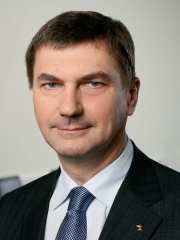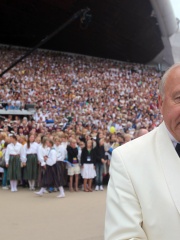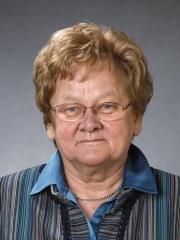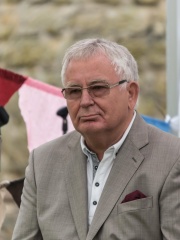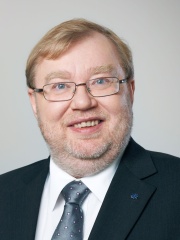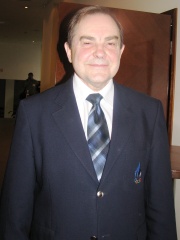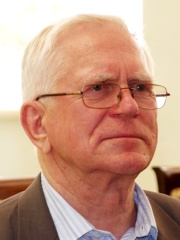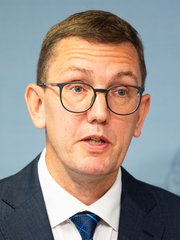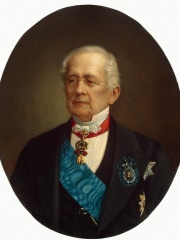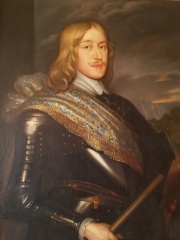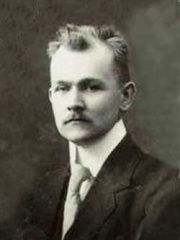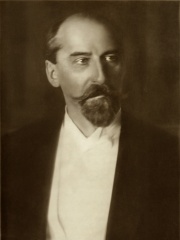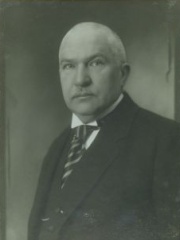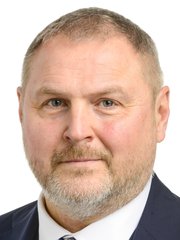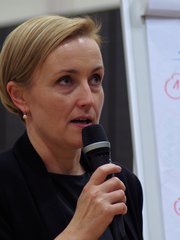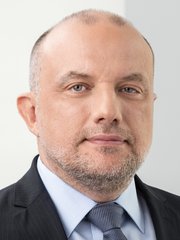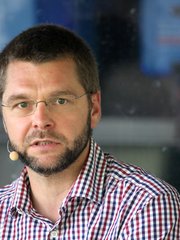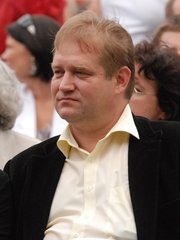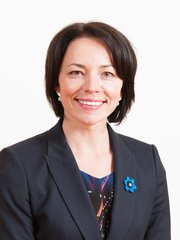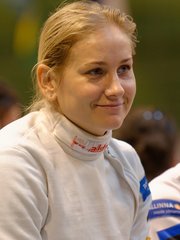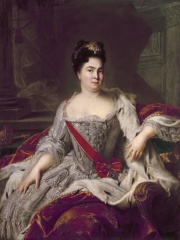
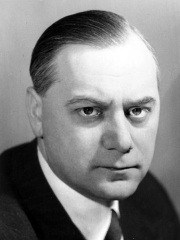
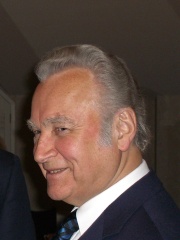
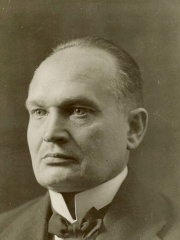

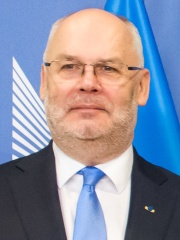
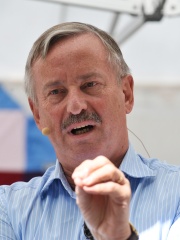
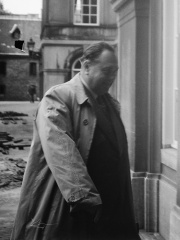
The Most Famous
POLITICIANS from Estonia
This page contains a list of the greatest Estonian Politicians. The pantheon dataset contains 19,576 Politicians, 85 of which were born in Estonia. This makes Estonia the birth place of the 43rd most number of Politicians behind Peru, and North Korea.
Top 10
The following people are considered by Pantheon to be the top 10 most legendary Estonian Politicians of all time. This list of famous Estonian Politicians is sorted by HPI (Historical Popularity Index), a metric that aggregates information on a biography's online popularity. Visit the rankings page to view the entire list of Estonian Politicians.

1. Catherine I of Russia (1684 - 1727)
With an HPI of 80.50, Catherine I of Russia is the most famous Estonian Politician. Her biography has been translated into 73 different languages on wikipedia.
Catherine I Alekseyevna Mikhailova (born Marta Samuilovna Skavronskaya; 15 April [O.S. 5 April] 1684 – 17 May [O.S. 6 May] 1727) was the second wife and Empress consort of Peter the Great, whom she succeeded as Empress of Russia, ruling from 1725 until her death in 1727.

2. Alfred Rosenberg (1893 - 1946)
With an HPI of 78.24, Alfred Rosenberg is the 2nd most famous Estonian Politician. His biography has been translated into 60 different languages.
Alfred Ernst Rosenberg (12 January [O.S. 31 December 1892] 1893 – 16 October 1946) was a Baltic German Nazi theorist, theologian, ideologue and convicted war criminal. Rosenberg was first introduced to Adolf Hitler by Dietrich Eckart, and he held several important posts in the Nazi government. He was the head of the NSDAP Office of Foreign Affairs during the entire rule of Nazi Germany (1933–1945), and led Amt Rosenberg ("Rosenberg's bureau"), an official Nazi body for cultural policy and surveillance, between 1934 and 1945. During World War II, Rosenberg was the head of the Reich Ministry for the Occupied Eastern Territories (1941–1945). He helped direct the mass murder of the Slavs. After the war, he was convicted of crimes against peace; planning, initiating and waging wars of aggression; war crimes; and crimes against humanity at the Nuremberg trials in 1946. He was sentenced to death by hanging and executed on 16 October 1946. The author of a seminal work of Nazi ideology, The Myth of the Twentieth Century (1930), Rosenberg is considered one of the main authors of key Nazi ideological creeds, including its racial theory and its hatred of the Jewish people, the need for Lebensraum, abrogation of the Treaty of Versailles, and opposition to what was considered "degenerate" modern art. He was also known for his hatred and rejection of what he regarded as "negative" Christianity; however, he played an important role in the development of German nationalist Positive Christianity, which rejected the Old Testament.

3. Arnold Rüütel (1928 - 2024)
With an HPI of 73.60, Arnold Rüütel is the 3rd most famous Estonian Politician. His biography has been translated into 52 different languages.
Arnold Rüütel (Estonian pronunciation: [ˈɑrːnolʲtʲ ˈryːtːːelʲ], 10 May 1928 – 31 December 2024) was an Estonian politician. He was the third President of Estonia from 8 October 2001 to 9 October 2006. Rüütel was the second president of the country after the end of the 1944–1991 Soviet occupation, and the restoration of the independent Republic of Estonia on 20 August 1991.

4. Konstantin Päts (1874 - 1956)
With an HPI of 71.63, Konstantin Päts is the 4th most famous Estonian Politician. His biography has been translated into 52 different languages.
Konstantin Päts (23 February [O.S. 11 February] 1874 – 18 January 1956) was an Estonian statesman and the country's president from 1938 to 1940. Päts was one of the most influential politicians of the independent democratic Republic of Estonia, and during the two decades prior to World War II he also served five times as the country's State Elder. After the 16–17 June 1940 Soviet invasion and occupation of Estonia, Päts remained formally in office for over a month, until he was forced to resign, imprisoned by the new Stalinist regime, and deported to the USSR, where he died in 1956. Päts was one of the first Estonians to become active in politics, and he then started a famous, nearly four-decade long, political rivalry with Jaan Tõnisson — first through journalism with his newspaper Teataja, later through politics. Although Päts was sentenced to death (in absentia) during the Russian Revolution of 1905, he was able to flee abroad, first to Switzerland, then to Finland, where he continued his literary work. He returned to Estonia (then part of the Russian Empire), and had to serve a prison sentence in 1910–1911. After the February Revolution in 1917, Päts headed the provincial government of the newly formed Autonomous Governorate of Estonia, which was forced to go underground after the Bolshevik coup in November 1917. On 19 February 1918, Päts became one of the three members of the Estonian Salvation Committee that issued the Estonian Declaration of Independence on 24 February 1918. He headed the Estonian Provisional Government (1918–1919), although he was also imprisoned by the German occupation regime for several months in 1918. In the provisional government, Päts also served as Minister of Internal Affairs (1918) and Minister of War (1918–1919) that left him in charge of organizing the Estonian military in the War of Independence against the Soviet Russian invasion. During the 1920s and early 1930s, Päts led one of the more prominent right-wing parties of the time – the conservative Farmers' Assemblies, which eventually merged into another party, the Union of Settlers and Smallholders in 1932. Päts was the Speaker of the Parliament (Riigikogu) (1922–1923) and served five times as State Elder, a post equivalent to that of president in Estonia's radically parliamentarian system (1921–1922, 1923–1924, 1931–1932, 1932–1933, and 1933–1934). During his last term as State Elder, he organized a self-coup to neutralise the right-wing populist Vaps Movement. He was supported by the army and the parliament. During the 1934–1938 "Era of Silence", many reforms were made and the economy grew, while he postponed the return of constitutional order. Largely supported by General Johan Laidoner, Commander of the Estonian Defence Forces, Päts ruled as Prime Minister in duties of the State Elder (1934–1937) and President-Regent (1937–1938) until a new constitution was adopted in 1938, after which Päts was elected the first President of Estonia. During his presidency, the Stalinist Soviet Union invaded and occupied Estonia in June 1940. As president, he was forced to sign decrees for over a month, until being arrested and deported to Soviet Russia, where he died in 1956.
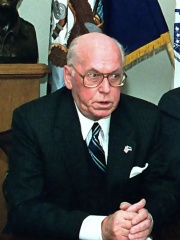
5. Lennart Meri (1929 - 2006)
With an HPI of 70.95, Lennart Meri is the 5th most famous Estonian Politician. His biography has been translated into 51 different languages.
Lennart Georg Meri (Estonian pronunciation: [ˈlenːɑrtː keˈorːːk ˈmeri]; 29 March 1929 – 14 March 2006) was an Estonian writer, film director, and statesman. He was the country's foreign minister from 1990 to 1992 and President of Estonia from 1992 to 2001.

6. Kaja Kallas (b. 1977)
With an HPI of 70.35, Kaja Kallas is the 6th most famous Estonian Politician. Her biography has been translated into 89 different languages.
Kaja Kallas (Estonian: [ˈkɑjɑ ˈkɑlːɑs]; born 18 June 1977) is an Estonian politician and diplomat. She was the first female prime minister of Estonia, a role she held from 2021 until 2024, when she resigned in advance of her appointment as High Representative of the European Union for Foreign Affairs and Security Policy. Since 2024, she has served in that role as well as Vice-President of the European Commission in the second von der Leyen Commission. The leader of the Estonian Reform Party since 2018, she was a member of parliament (Riigikogu) in 2011–2014, and 2019–2021. Kallas was a member of the European Parliament in 2014–2018, representing the Alliance of Liberals and Democrats for Europe. Before her election to Riigikogu, she was a lawyer specialising in European competition law.

7. Alar Karis (b. 1958)
With an HPI of 68.89, Alar Karis is the 7th most famous Estonian Politician. His biography has been translated into 52 different languages.
Alar Karis (Estonian pronunciation: [ˈɑlɑr ˈkɑris]; born 26 March 1958) is the sixth president of Estonia, having taken office on 11 October 2021. He previously worked as molecular geneticist, developmental biologist, and Estonian civil servant.

8. Siim Kallas (b. 1948)
With an HPI of 68.51, Siim Kallas is the 8th most famous Estonian Politician. His biography has been translated into 35 different languages.
Siim Kallas (Estonian pronunciation: [ˈsiːːm ˈkɑlːɑs]; born 2 October 1948) is an Estonian former politician who served as Prime Minister of Estonia from 2002 to 2003 and as a European Commissioner from 2004 to 2014. From 1972 to 1990 Kallas was a member of the Communist Party of the Soviet Union. He worked in the finance ministry of Estonian SSR and was the director of the Estonian branch of State Labor Savings Banks System in 1986-1989. In 1987, Kallas was one of the authors of the IME plan for self-managing Estonia with Tiit Made, Edgar Savisaar and Mikk Titma. The plan proposed to make Estonia economically independent from the Soviet Union – adopting a market economy and establishing Estonia’s own currency and tax system. Kallas was the chief editor of Rahva Hääl, the official newspaper of the Communist Party of Estonia, in 1989-1991. He was elected a member of the Congress of People's Deputies of the Soviet Union in the 1989 Soviet Union legislative election, the first partially free elections in the Soviet Union. After Estonia restored its independence in 1991, Kallas was appointed the President of the Bank of Estonia, which at the time had only 11 employees. Within a year a coherent structure of the bank was set up and on 20 June 1992, Estonia's own currency, the kroon, was back in circulation for the first time since 1941. Kallas entered politics in 1994 as one of the founders of liberal Estonian Reform Party, which was successful in the 1995 parliamentary elections. Kallas served as the minister of foreign affairs from 1995 to 1996. He later served as the minister of finance from 1999 to 2002 and the prime minister from 2002 to 2003. He served as the European Commissioner for Transport between 2010 and 2014. Before that he was the European Commissioner for Administrative Affairs, Audit and Anti-Fraud between 2004 and 2009. In both Barroso Commissions he was also a Vice-President. He was twice appointed the Acting Commissioner for Economic and Monetary Affairs and the Euro in Olli Rehn's stead, from 19 April 2014 to 25 May 2014 while he was on electoral campaign leave for the 2014 elections to the European Parliament and from 1 July 2014 to 16 July 2014 after he took up his seat. After leaving the European Commission, Kallas ran in the Estonian presidential election in 2016, but was not elected. In October 2017, he started as the municipal mayor of Viimsi Parish. In 2019 he was elected member of the Riigikogu, a post he was also elected to in 2023. He resigned as a member of Riigikogu and from politics in September 2024. His daughter, Kaja Kallas, was the prime minister of Estonia from 2021 to 2024.

9. Felix Kersten (1898 - 1960)
With an HPI of 67.67, Felix Kersten is the 9th most famous Estonian Politician. His biography has been translated into 23 different languages.
Eduard Alexander Felix Kersten (30 September 1898 – 16 April 1960) was the personal physical therapist of Reichsführer-SS Heinrich Himmler.
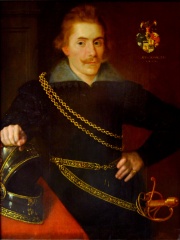
10. Jacob De la Gardie (1583 - 1652)
With an HPI of 66.81, Jacob De la Gardie is the 10th most famous Estonian Politician. His biography has been translated into 21 different languages.
Field Marshal and Count Jacob Pontusson De la Gardie (20 June 1583 – 22 August 1652) was a statesman and a soldier of the Swedish Empire, and a Marshal from 1620 onward. He was Privy Councilor from 1613 onward, Governor of Swedish Estonia in 1619–1622, Governor-General of Livonia in 1622–1628 (conquered by the Swedish Empire in 1621, and referred to as Swedish Livonia in 1629–1721), and Lord High Constable from 1620. He introduced reforms based on the then novel Dutch military doctrine into the Swedish army. He commanded the Swedish forces in Russia and against the Polish–Lithuanian Commonwealth. He also served as one of the five regents jointly ruling Sweden during the minority of Queen Christina.
People
Pantheon has 85 people classified as Estonian politicians born between 1583 and 1986. Of these 85, 45 (52.94%) of them are still alive today. The most famous living Estonian politicians include Kaja Kallas, Alar Karis, and Siim Kallas. The most famous deceased Estonian politicians include Catherine I of Russia, Alfred Rosenberg, and Arnold Rüütel. As of April 2024, 9 new Estonian politicians have been added to Pantheon including Kristen Michal, Riho Terras, and Kristina Kallas.
Living Estonian Politicians
Go to all RankingsKaja Kallas
1977 - Present
HPI: 70.35
Alar Karis
1958 - Present
HPI: 68.89
Siim Kallas
1948 - Present
HPI: 68.51
Andrus Ansip
1956 - Present
HPI: 66.36
Kersti Kaljulaid
1969 - Present
HPI: 65.53
Neeme Järvi
1937 - Present
HPI: 64.49
Ene Ergma
1944 - Present
HPI: 61.72
Tiit Vähi
1947 - Present
HPI: 60.29
Mart Laar
1960 - Present
HPI: 59.60
Mart Siimann
1946 - Present
HPI: 59.42
Andres Tarand
1940 - Present
HPI: 59.12
Kristen Michal
1975 - Present
HPI: 57.65
Deceased Estonian Politicians
Go to all RankingsCatherine I of Russia
1684 - 1727
HPI: 80.50
Alfred Rosenberg
1893 - 1946
HPI: 78.24
Arnold Rüütel
1928 - 2024
HPI: 73.60
Konstantin Päts
1874 - 1956
HPI: 71.63
Lennart Meri
1929 - 2006
HPI: 70.95
Felix Kersten
1898 - 1960
HPI: 67.67
Jacob De la Gardie
1583 - 1652
HPI: 66.81
Alexander Gorchakov
1798 - 1883
HPI: 64.89
Magnus Gabriel De la Gardie
1622 - 1686
HPI: 64.06
Bernhard Schmidt
1879 - 1935
HPI: 63.15
Jaan Tõnisson
1868 - 1941
HPI: 62.81
Friedrich Akel
1871 - 1941
HPI: 62.23
Newly Added Estonian Politicians (2025)
Go to all RankingsKristen Michal
1975 - Present
HPI: 57.65
Riho Terras
1967 - Present
HPI: 47.16
Kristina Kallas
1976 - Present
HPI: 46.84
Helir-Valdor Seeder
1964 - Present
HPI: 46.82
Jüri Luik
1966 - Present
HPI: 45.72
Jevgeni Ossinovski
1986 - Present
HPI: 44.24
Ivari Padar
1965 - Present
HPI: 42.07
Liina Kersna
1980 - Present
HPI: 37.12
Kristina Kuusk
1985 - Present
HPI: 35.92
Overlapping Lives
Which Politicians were alive at the same time? This visualization shows the lifespans of the 25 most globally memorable Politicians since 1700.

